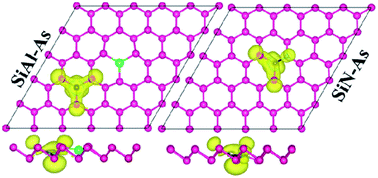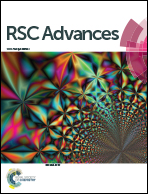Effect of Si, Be, Al, N and S dual doping on arsenene: first-principles insights†
Abstract
First-principles calculations based on density functional theory (DFT) have been performed to investigate the effect of Si/Be, Si/Al, Si/N and Si/S co-doping on the geometries, electronic structure, magnetism and particularly the adsorption of CO in arsenene. The results show that the incorporation of foreign atoms slightly distorts the host lattice. All doped structures are found to be thermodynamically stable. The replacement of host As atoms with foreign atoms results in some interesting changes in the electronic and magnetic properties of arsenene. The doped arsenene systems exhibit a semiconducting character with band gaps smaller than the original value of 1.59 eV due to the emergence of defect states within the actual band gap. Besides, arsenene remains nonmagnetic (NM) upon Si/Be or Si/S dual doping, whereas both Si/Al and Si/N dopings induce magnetism with a total magnetic moment of 1 μB. Finally, the adsorption of CO molecules over pristine arsenene (p-As) and dual doped arsenene systems is investigated in terms of adsorption energy, adsorption height, charge transfer, charge density difference (CDD), work function, electronic band structures and density of states. It is observed that CO molecule has physisorption over p-As, SiAl–As, SiN–As and SiS–As systems, whereas chemisorption is reported for the SiBe–As system. Our study suggests that chemically modifying arsenene with suitable dopants might extend its applications in spintronic and gas sensing applications.



 Please wait while we load your content...
Please wait while we load your content...